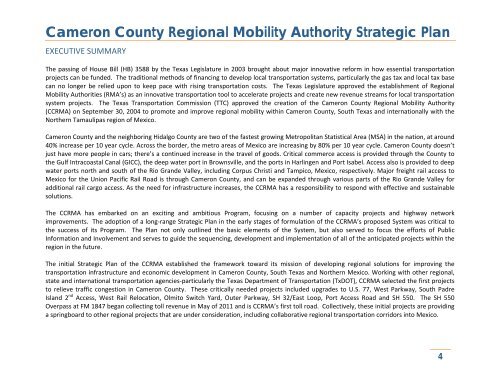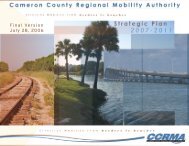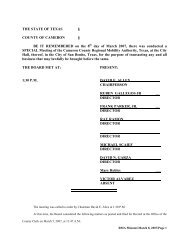CCRMA Strategic Plan 2012-2016 - Cameron County Regional ...
CCRMA Strategic Plan 2012-2016 - Cameron County Regional ...
CCRMA Strategic Plan 2012-2016 - Cameron County Regional ...
You also want an ePaper? Increase the reach of your titles
YUMPU automatically turns print PDFs into web optimized ePapers that Google loves.
<strong>Cameron</strong> <strong>County</strong> <strong>Regional</strong> Mobility Authority <strong>Strategic</strong> <strong>Plan</strong>EXECUTIVE SUMMARYThe passing of House Bill (HB) 3588 by the Texas Legislature in 2003 brought about major innovative reform in how essential transportationprojects can be funded. The traditional methods of financing to develop local transportation systems, particularly the gas tax and local tax basecan no longer be relied upon to keep pace with rising transportation costs. The Texas Legislature approved the establishment of <strong>Regional</strong>Mobility Authorities (RMA’s) as an innovative transportation tool to accelerate projects and create new revenue streams for local transportationsystem projects. The Texas Transportation Commission (TTC) approved the creation of the <strong>Cameron</strong> <strong>County</strong> <strong>Regional</strong> Mobility Authority(<strong>CCRMA</strong>) on September 30, 2004 to promote and improve regional mobility within <strong>Cameron</strong> <strong>County</strong>, South Texas and internationally with theNorthern Tamaulipas region of Mexico.<strong>Cameron</strong> <strong>County</strong> and the neighboring Hidalgo <strong>County</strong> are two of the fastest growing Metropolitan Statistical Area (MSA) in the nation, at around40% increase per 10 year cycle. Across the border, the metro areas of Mexico are increasing by 80% per 10 year cycle. <strong>Cameron</strong> <strong>County</strong> doesn’tjust have more people in cars; there’s a continued increase in the travel of goods. Critical commerce access is provided through the <strong>County</strong> tothe Gulf Intracoastal Canal (GICC), the deep water port in Brownsville, and the ports in Harlingen and Port Isabel. Access also is provided to deepwater ports north and south of the Rio Grande Valley, including Corpus Christi and Tampico, Mexico, respectively. Major freight rail access toMexico for the Union Pacific Rail Road is through <strong>Cameron</strong> <strong>County</strong>, and can be expanded through various parts of the Rio Grande Valley foradditional rail cargo access. As the need for infrastructure increases, the <strong>CCRMA</strong> has a responsibility to respond with effective and sustainablesolutions.The <strong>CCRMA</strong> has embarked on an exciting and ambitious Program, focusing on a number of capacity projects and highway networkimprovements. The adoption of a long‐range <strong>Strategic</strong> <strong>Plan</strong> in the early stages of formulation of the <strong>CCRMA</strong>’s proposed System was critical tothe success of its Program. The <strong>Plan</strong> not only outlined the basic elements of the System, but also served to focus the efforts of PublicInformation and Involvement and serves to guide the sequencing, development and implementation of all of the anticipated projects within theregion in the future.The initial <strong>Strategic</strong> <strong>Plan</strong> of the <strong>CCRMA</strong> established the framework toward its mission of developing regional solutions for improving thetransportation infrastructure and economic development in <strong>Cameron</strong> <strong>County</strong>, South Texas and Northern Mexico. Working with other regional,state and international transportation agencies‐particularly the Texas Department of Transportation (TxDOT), <strong>CCRMA</strong> selected the first projectsto relieve traffic congestion in <strong>Cameron</strong> <strong>County</strong>. These critically needed projects included upgrades to U.S. 77, West Parkway, South PadreIsland 2 nd Access, West Rail Relocation, Olmito Switch Yard, Outer Parkway, SH 32/East Loop, Port Access Road and SH 550. The SH 550Overpass at FM 1847 began collecting toll revenue in May of 2011 and is <strong>CCRMA</strong>’s first toll road. Collectively, these initial projects are providinga springboard to other regional projects that are under consideration, including collaborative regional transportation corridors into Mexico.4




